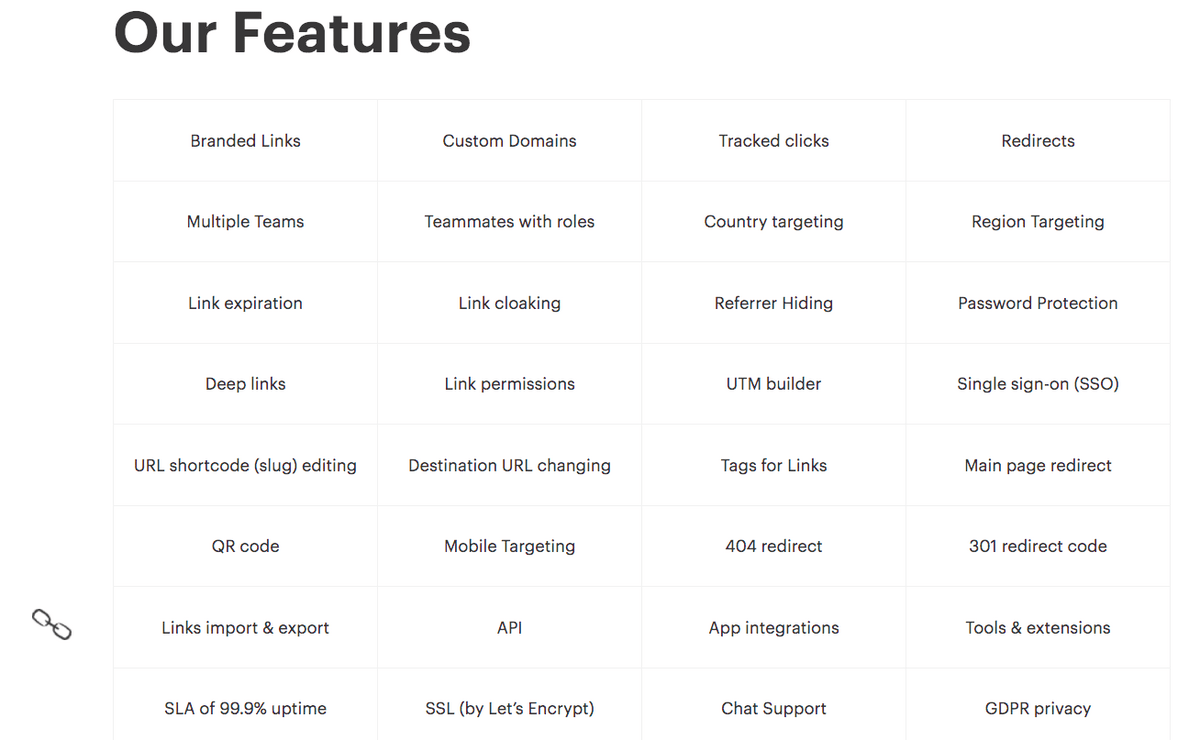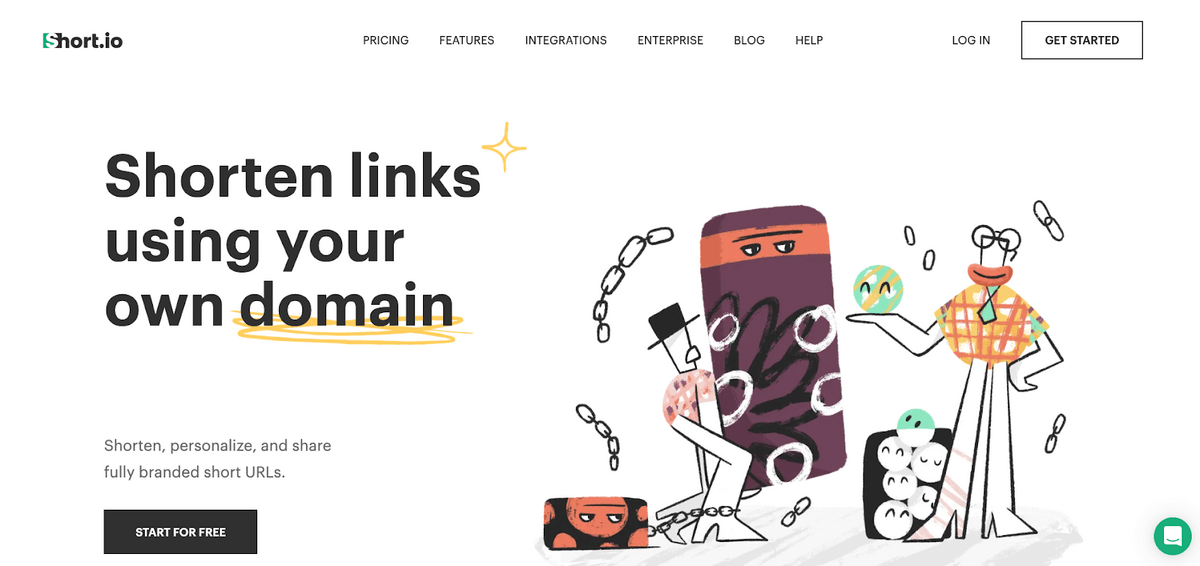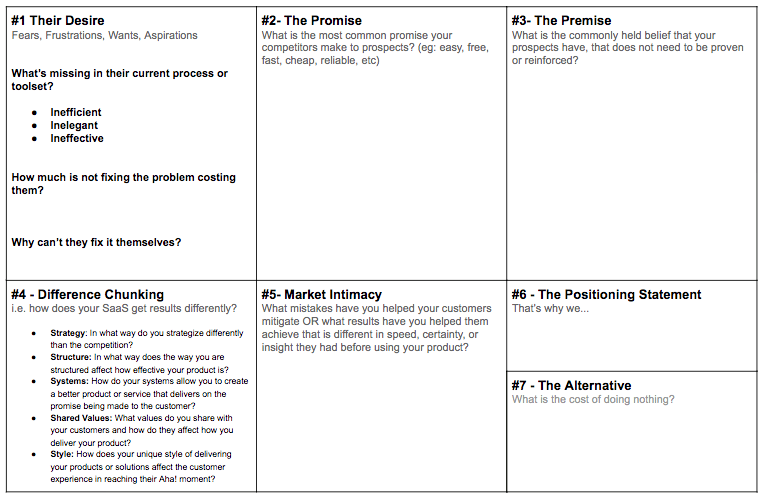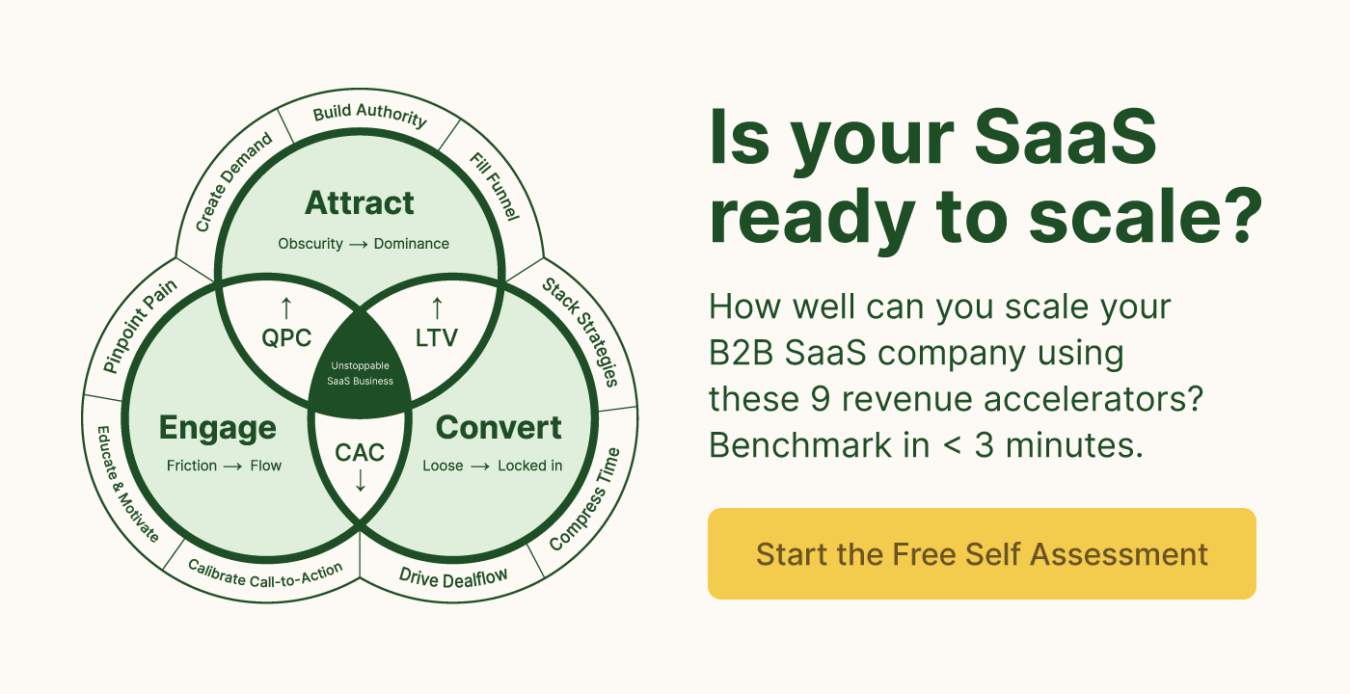Why B2B SaaS Companies Should Avoid All-in-One Positioning (And What You Can Do Instead)
Last updated: January 8th, 2024
Many B2B SaaS companies that have broad feature sets position themselves as all-in-one solutions for their customers.
On the surface, this might seem like the right approach because there are many acute problems you can solve for customers. But more often than not, all-in-one positioning hinders — rather than benefits — the appeal of your product.
That’s because it creates three significant obstacles that are hard to overcome:
- Switching risks: Any time a business switches SaaS products, there’s a cost in time and effort to learn the new solution and adapt it into their workflow. This can be difficult enough when your product replaces a single solution. But all-in-one positioning implies it can replace several (often many) tools in a business’s tech stack. This compounds the switching risk for companies and often leads to resistance from internal stakeholders who are happy using the tools they know.
- Not problem-focused: The reality is that most B2B SaaS buyers look to purchase specific tools to solve specific problems. They generally aren’t looking for a holistic piece of software that helps run their entire business.
- Vague differentiation: All-in-one positioning doesn’t provide your prospects with any understanding of what makes your product unique or better than your competition.
As a result of these challenges, B2B SaaS companies that use all-in-one positioning suffer consequences that impact their bottom line, such as:
- Failing to gain market share
- Confusing prospects who visit their website
- Attracting poor quality leads
- Falling flat in their marketing
Not all, but many companies that go this route struggle to stay in business. They never realize that their positioning is the underlying issue that leads to these downstream problems.
In this article we explain why specific, pain-point-focused positioning is a much more effective approach. Then we cover how to use our SaaS Positioning Canvas to discover pain points to feature in your positioning. And we share an example of how one of our recent clients used it to transition from all-in-one to pain point positioning.
Struggling to find the right positioning for your B2B SaaS product? Get your Free Marketing Plan to find out more about how we can help you overcome this challenge.
Avoid all-in-one positioning: Focus on the specific pain you solve, instead
Make no mistake: we’re not saying that you shouldn’t build all-in-one software. You can.
What we are saying is that all-in-one positioning often causes friction and resistance when it comes to marketing and selling your product.
There are exceptions. For example, some companies like Notion manage to make all-in-one positioning work. But most do not.
Instead of all-in-one, you should narrow down your positioning to communicate the biggest pain point you solve for customers. Then, use that to differentiate yourself, grab the interest of prospects, and get your foot in the door.
Once you’ve earned their trust and solved one painful problem for them, you can begin to:
- Educate them on the other problems you can solve
- Show them how your other features solve those problems
- Upsell them to expand product usage over time
A great example of a company that positions itself this way is a link-shortening company called Short.io. Take a look at their feature set:

They could have easily chosen to position themselves as an all-in-one solution for URL, link management and channel analytics. But instead, they chose to use focused, pain point positioning with a clear message aligned to that positioning:

Most link shortening services don’t let users use their own branded URL in their shortened links. As a result, it’s difficult for users to establish trust with potential customers, who only see a generic link on the front end.
By narrowing their positioning, they’re able to avoid the common pitfalls of the all-in-one approach, like switching risks. Short.io isn’t trying to convince prospects to choose their product based on its broad set of features. Instead, prospects are asked to decide based on a single feature that addresses a crucial pain point.
And because their positioning is problem-focused, it’s more aligned with the way that B2B SaaS buyers make purchasing decisions. They buy to solve a specific problem with a specific tool. In this context, that problem is the inability to establish trust with potential customers due to generic shortened links.
Finally, Short.io’s pain-point-centered positioning differentiates itself from the competition. Other link-shortening services don’t usually enable users to use their own domain when creating custom links. Short.io’s promise is to enable users to shorten their own links with branded URLs.
Through this simple decision to go narrow rather than wide, Short.io can overcome the obstacles that companies using all-in-one positioning typically face.
Now let’s say you want to follow suit and use pain point positioning for your own company. How do you figure out which pain points to focus on? There’s a methodical approach that we use with all of our clients that you can use yourself.
Nail your positioning with the SaaS Positioning Canvas
We’ve created a tool that helps you clarify the biggest pain points you solve for customers, and implement that into your positioning. We call it the SaaS Positioning Canvas.

The canvas provides a 7-step process for defining what makes your product different in the context of problems you solve for your target audience. If you want to redefine your positioning, you can use this canvas to figure out which pain points to focus on.
We recently did this exercise with a client who had been using all-in-one positioning. They provide professional services management software. And they’d gone the all-in-one route because:
A) They offer a wide feature set for centralizing the majority of business operations.
B) It’s what every competitor in their market has done.
By working through the canvas together, we discovered that the pain point their customers actually have is that running a professional services firm is chaotic. All the spreadsheets, client communication, billing, and document management happen with disparate systems. And business is difficult to manage and scale as a result.
To demonstrate how this works, here’s a summary of the points they identified in the canvas, and the new pain point positioning they decided on.
Step 1: Their Desire
In the first phase of the canvas, your goal is to find out what’s missing in your prospects’ current process or toolset. This boils down to deciphering what your ideal customer’s fears, frustrations, wants, and aspirations are.
Next, you’d determine the cost of not fixing the problem your customers currently face. Then finally, to build upon that tension, you combine the cost of not fixing the problem with an explanation of why it’s been so difficult to solve.
Here’s what our client came up with:
What’s missing in their current process or toolset?
- Client communication and the workflow around critical tasks like invoicing, coordinating, account management and onboarding clients is inefficient.
- They’re struggling to manage the mess of their current process.
- They’re using a lot of tools — some not purpose built — and they lack consistency of process and clarity of their data.
How much is not fixing the problem costing them?
- For directors, current systems are creating busy work and that means they can’t take on additional work without adding staff. This stagnates growth in their firm.
- The office manager is currently so focused on the management of their systems that they can’t focus on the management of the firm. This has a big impact on quality of life and employee happiness — they’re run ragged by tasks that don’t really move the needle. They’re just doing paperwork all the time.
Why can’t they fix it themselves?
- The decision maker might be set in their ways, with a mindset of: “why do we need another tool when we have all these systems in place?”
- The office manager is so busy with managing their current systems.
- The office manager ultimately needs the director’s support to make decisions that are fundamental to the firm — like moving all their data into one place and replacing ‘systems that have always worked’.
Together, these 3 objectives helped them specify and define the problems their prospects want to solve. This clarified their own understanding and now allows them to communicate that they understand those desires in a way that resonates more with prospects.
Step 2: The Promise
In order to create differentiation in your positioning, you first need to understand the promises your competitors are making to the market and the way they’re positioning themselves.
So step 2 of the canvas involves looking at your top 5 competitors, and listing the promises they’re making to prospects.
When our client did this, they found their competitors are all making the same basic promises:
- We make work easier — so you can profit
- We make you efficient — so you can profit
- We hold data securely
- All-in-one
- We’re beautiful/elegant
- And in some cases: we’re cheap
With these in mind, they had a reference for ensuring the positioning they chose was different than their competitors.
Step 3: The Premise
As they first encounter your product, prospects will likely be skeptical about the claims you make. To counter this, it’s best to make claims that they already accept or believe.
Your goal in step 3 is to come up with a statement that your customers would nod their heads and agree with as soon as they heard it. The right premise will help you build connections with your prospects.
In the case of our client, they determined premises for their 2 main buyer personas:
- Decision Maker — Director: Managing a firm is chaotic. Too much work, too little time. This business would be amazing except for the clients. We can’t live with them but can’t live without them.
- Influencer — Office Manager: Managing directors are love-hate. Bossy, pushy, egotistical, stubborn — but we kind of love them for it.
So how can you find the right claim to make in your positioning?
One way is to imagine yourself walking into a party full of potential customers. To blend in, ask yourself: “What is the joke that you could tell that they would all laugh at because it’s a shared belief about their industry?” The answer to that question will help you unlock this part of your positioning.
Step 4: Difference Chunking
You and your competitors may deliver the same results for your customers. But how you both get there is likely different.
Step 4 calls for you to articulate those differences. It’s useful to look at the following categories of differentiators:
- Strategy: In what ways do you strategize differently than your competitors?
- Structure: How does the structure of your business relate to how effective your product is?
- Systems: How do your systems allow you to create a better product or service that delivers on the promise being made to the customer?
- Shared Values: What values do you share with your customers and how do they affect how you deliver your product?
- Style: How does your unique style of delivering your products or solutions affect the customer experience in reaching their “Aha!” moments?
When our client arrived at this step of the exercise, they pinpointed their differentiators were in strategy and systems:
“Our competitors promise an all in one solution but actually they mean they’ll allow you to integrate a lot of different data sources into one place. Our system is different in that we build everything natively. This means the workflow is more robust and less ‘persnickety’ to use for our customers.”
Step 5: Market Intimacy
Step 5 is about establishing your authority and expertise of your industry to your prospects. In doing so, your positioning will demonstrate that you understand the challenges they face. That will lead them to trust you have a product that serves them.
To establish your authority and expertise, acknowledge the common mistakes that most customers make before they turn to your product. Also think about the results you deliver that speak to speed, certainty, and insight, which are all primary reasons why companies invest in a new product.
Here’s what our client came up with for this phase in the canvas:
- We’ve helped them to grow their businesses by bringing all of their processes together
- We’ve enabled them to have success within their firm by helping them to manage their workload and work/life balance for more efficiency
- We’ve effectively become an operating system for them that has replaced their chaotic filing cabinet systems
A simple list like this is enough. From here, you move onto crafting your positioning statement.
Step 6: The Positioning Statement
This next step is about framing your mission in relation to the list of mistakes you noted in the last step. You’ll do this by completing the statement, “That’s why we…”
This should be no longer than 2 to 3 sentences. Use the previous steps to sum up what your product does and how it differs from competitors in brief terms.
Our client crafted the following positioning statement:
“Focus on bringing calm to small-to-medium accountancy firms by providing a tool to replace the inefficient and disparate systems that prevent directors from doing client’s financial work and office managers from getting bogged down with chasing paperwork.”
Note: A lot of people try to get into ‘copywriting mode’ here. They’ll try to imagine what the headline on their homepage will read. This is actually a real mistake for two reasons:
- Most people aren’t as good at copywriting as they think they are — they actually miss out on key pain points and ideas that differentiate their positioning because they’re trying to fit everything into a single, catchy sentence.
- They get hung up on arguing about terminology — time and time again, we’ve watched teams say, “I don’t like this word” or “would our customers know what that means?” While there’s a time and a place for that, this positioning statement is internal. It’s to help you all pull together and move onto strategic messaging later — your clients won’t see it and no one is stuck like glue to the specifics.
Step 7: The Alternative
The last step of the SaaS Positioning Canvas calls for you to describe the cost of doing nothing. Explain what your prospect stands to lose over the long haul by not buying your product.
The answer in this step is similar to the assumptions you made in step 1. The difference though is demonstrating how the cost of doing nothing compounds the problems they face today, as well as months and years into the future.
The alternative our client came up with was the following:
“Managing Directors risk stagnated growth because office managers can’t manage more clients. Office managers suffer too because Directors need to ask them a lot of questions about their work because the answers will remain in spreadsheets that only the office manager can locate.”
Acknowledging and stating this potential consequence is enough to move their prospects closer to purchase.
The Result: Our Client’s New Pain Point Positioning
Through completing their canvas, our client condensed their discoveries into the following pain point positioning:
“We provide you a platform to help tame the chaos of running a professional services firm, helping you create a calm, productive workflow so that you can grow your firm.”
Note: To use this tool, make a copy of the SaaS Positioning Canvas and paste it into your own document to begin filling it out. No need to ask for edit access. (For the canvas to paste properly, go to File > Page Setup > Landscape and adjust the margins from 1” to 0.5” across the board.)
Apply what you’ve learned to create pain point positioning
After filling out your own SaaS Positioning Canvas, go back and review your list of prospect desires from step 1. Also, revisit the ideas you listed in the box on difference chunking in step 4.
Use what you came up with in those sections to brainstorm ideas for new positioning based on specific pain points and differentiators. Once you’ve identified a handful of options, craft a few versions of your home page headline that convey your new positioning.
Then, test what you’ve drafted. A few options to do this include:
- Set up landing pages and run A/B tests with Google Optimize (if you have enough traffic)
- Run focus groups composed of ideal or existing customers
- Use a service like Wynter, which provides message testing specifically for B2B companies
Commit to the positioning that resonates most with your customers based on the results of those tests.
By positioning based on pain points, you’ll guarantee that your product isn’t competing to displace one or more existing tools that your prospects already love.
You’ll also find a stronger product-market fit, leading you to draw in better prospects and leads.
And it’ll help you stand out from other B2B SaaS products that have committed to the vague promise of all-in-one positioning. It might seem counterintuitive, but by getting specific, you’ll get more of the right customers in the long run.
Need help with articulating your positioning in a way that speaks to your customer’s pain points? Get your Free Marketing Plan to learn more about our process and what we can do to help.
What you should do now
Whenever you’re ready…here are 4 ways we can help you grow your B2B software or technology business:
- Claim your Free Marketing Plan. If you’d like to work with us to turn your website into your best demo and trial acquisition platform, claim your FREE Marketing Plan. One of our growth experts will understand your current demand generation situation, and then suggest practical digital marketing strategies to hit your pipeline targets with certainty and predictability.
- If you’d like to learn the exact demand strategies we use for free, go to our blog or visit our resources section, where you can download guides, calculators, and templates we use for our most successful clients.
- If you’d like to work with other experts on our team or learn why we have off the charts team member satisfaction score, then see our Careers page.
- If you know another marketer who’d enjoy reading this page, share it with them via email, Linkedin, Twitter, or Facebook.
